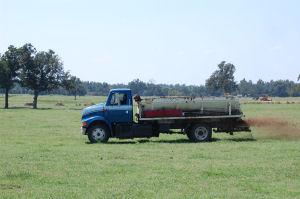What Is Manure Worth Compared to Commercial Fertilizer?
Animal manure is considered an agricultural commodity that can be utilized as a fertilizer source for pastureland, cropland and hay production. Manure is recognized as an excellent source of the plant nutrients nitrogen (N), phosphorus (P) and potassium (K). In addition, manure returns organic matter and other nutrients such as calcium, magnesium and sulfur to the soil, building soil fertility and quality.
Any financial valuation of manure would be dependent on the market value of the N, P, K, and other plant nutrients that the manure is replacing, organic matter as a soil amendment, and the nutrient needs of the crops and fields receiving the litter.
The nutrient content of manure will vary depending on animal type and diet, type and amount of bedding, manure moisture content, and storage method. For more information, see the Clemson University publication Livestock Manure Production Rates and Nutrient Content.
Buyers and sellers should have a lab analysis to determine moisture and nutrient concentration of the manure. Generally speaking, liquid manures will contain a lower nutrient content than solid manures, due to the dilution effect. Assuming all nutrients are needed by the crop, higher manure nutrient content corresponds to higher manure value. Higher values help to offset transportation and handling costs.

Manure Composition
Nitrogen in Manure
Nitrogen in manure is found in the organic and inorganic forms. The organic form (slow release) slowly mineralizes providing plant-available N, while inorganic forms (fast release) consist primarily of NH4-N and are immediately plant available. However, inorganic forms are also susceptible to loss through ammonia volatilization during storage and field application. Promptly incorporating the manure into the soil can reduce these N losses. Due to the slow release organic form and potential losses of the inorganic form, not all of the N is available to the crops during the year of application. Nitrogen that is expected to be available to the plant has value as a fertilizer. The N which is lost to the environment or which is not available to the crop in the year it is needed or subsequent years does not have value. The guide “Fertilizer Nutrients in Animal Manure” provides information on the amount of N expected to be available in the 1st year and subsequent years from various manure sources:
Phosphorus and Potassium in Manure
Phosphorus and Potassium in manure are mostly present in the inorganic form. This means that P and K are similar to commercial fertilizer in that they are readily available for plant uptake. Most nutrient management plans are based on a P-Index or P-threshold which may limit manure application on some fields. Therefore, the value of these nutrients is based on crop nutrient needs as determined by a soil test and yield goal.
Micronutrients in Manure
Other nutrients such as calcium (Ca), magnesium (Mg) and sulfur (S) may be found in manure and are beneficial to the soil if a deficiency exists. Both Ca and Mg create an added value by producing a liming effect when added to the soil.
Organic Matter
Organic matter, primarily undigested feed and bacteria in the feces, increases infiltration of water, increases water holding capacity, enhances retention of nutrients, reduces wind and water erosion and promotes the growth of beneficial organisms when added to the soil. Although the value of organic matter is hard to quantify, higher quality soils are associated with increased yields and higher economic returns.
Manure As a Plant Fertilizer
Because manure is not a balanced fertilizer, some plant nutrient needs may be met while other nutrients may be under- or over-supplied. Any nutrient that is undersupplied by a manure application could incur a subsequent fertilizer application cost which would, in effect, lower the net value of the manure. Any nutrient that is oversupplied by a manure application would not have immediate value because it was not needed by the crop.
Additional Links
- Oklahoma Soil Test Interpretation and Fertilizer Decision Support Program including animal manure value calculator
- Oklahoma Poultry Litter Value Calculator
- Alabama Nutrient Contents of Fertilizer Materials
- Manure Value Calculator spreadsheet by University of Minnesota
Authors: Josh B. Payne, Oklahoma State University and John Lawrence, Iowa State University
Reviewers: Ray Massey, University of Missouri and Kelsi Bracmort, NRCS

